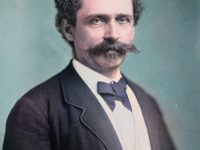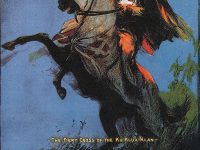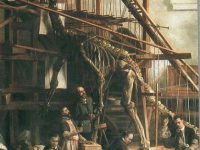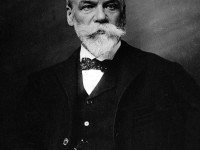
Hergé’s signature
On May 22, 1907, Belgian cartonist Georges Prosper Remi, better known under his pen name Hergé, was born. His best known and most substantial work is the 23 completed comic books in The Adventures of Tintin series.
Background Hergé
Georges Prosper Remi grew up in the suburbs of Brussels, Belgium, which he considered as extremely boring. However, he developed a great interest in movies, especially the ones of Charlie Chaplin and Winsor McCay’s Gertie the Dinosaur. Furthermore, he enjoyed British and American novels like Huckleberry Finn, Treasure Island, Robinson Crusoe [4] and The Pickwick Papers. He also began to sketch out scenes from his everyday life, which increased his enthusiasm in drawing. He was highly supported by his boy scout master, who published one of his drawings in a newsletter. Further publications in the Belgian boy scout newsletter followed and the young artist began experimenting with several pseudonyms, such as “Jérémie” or “Jérémiades“. “Hergé” is based on the pronunciation of his reversed initials (R.G.) and he first used his now famous pseudonym in December 1924. Hergé’s first published comic strip was titled “Les Aventures de Totor, C.P. des Hannetons” and revolved around the adventures of a Boy Scout patrol leader. He also sought guidance from an older cartoonist, Pierre Ickx, and together they founded the short lived Atelier de la Fleur de Lys, an organisation for Christian cartoonists.
Tintin Revient
The young artist enrolled at in the École Saint-Luc art school, which he found boring and left after only one lesson. Due to his boredom, he enlisted for military service before he was called up, and in August 1926 was assigned to the Dailly barracks at Schaerbeek. He was still bored by the military training, but in his free time, he managed to continue sketching and producing episodes of Totor. When he met the editor of Le XXe Siecle, the Abbé Norbert Wallez, he was hired as a photographic reporter and cartoonist for the paper. In 1928, Wallez founded a newpaper supplement for children, Le Petit Vingtième. It appeared once a week and Hergé illustrated L’Extraordinaire Aventures de Flup, Nénesse, Puosette et Cochonet for the paper. However, he increasingly felt the need to publish a comic strip of his own. The front page of the 1 May 1930 edition of Le Petit Vingtième declared that “Tintin Revient!” (“Tintin Returns!“) from his adventure in the Soviet Union.
The Adventures of Tintin
The famous Tintin character was born. He was a Belgian boy reporter who traveled the world with his fox terrier, Milou. Although Hergé wanted to send his character to the United States, Wallez instead ordered him to set his adventure in the Soviet Union. The story was published as a series and even a book of Tintin’s adventured followed shortly after, which increased his fame even more. In his next adventure, the character was sent to Congo. Unfortunately, in later decades the story would be accused of racism, but at the time, it was un-controversial and popular. Tintin in America was serialized from September 1931 to October 1932. Hergé became quite famous and international newspapers started requesting his works.
Further works of the period were The Lovable Mr. Mops and The Adventures of Tim the Squirrel Out West. From August 1934 to October 1935, Le Petit Vingtième serialised Tintin’s next adventure, The Blue Lotus. It was set in China and Hergé’s production work was highly influenced by his friend Zhang Chongren, a Catholic Chinese student. Zhang gave him lessons in Taoist philosophy, Chinese art, and Chinese calligraphy, influencing not only his artistic style but also his general outlook on life. Hergé added another character to his series, a young Chinese boy named Chang Chong-Chen who meets and befriends Tintin. The Blue Lotus has been widely considered as “Hergé’s first masterpiece“, due to high attention to accuracy, resulting in a largely realistic portrayal of China. In 1936, they also began production of Tintin merchandise, something Hergé supported,. He even developed the idea of an entire shop devoted to The Adventures of Tintin, which was accomplished about 50 years later.
World War II
Hergé was mobilized as a reserve lieutenant during the Second World War and had to interrupt Tintin’s adventures. Le Petit Vingtième was shut down by the Nazi occupiers and Hergé launched The Crab with the Golden Claws, the first of six Tintin stories which he produced during the war. In the future, Hergé had to move the focus of Tintin’s adventures away from current affairs, in order to avoid controversy. Also, the comic strip was changed to a daily three- or four-frame strip instead of two complete pages every week. Therefore, Hergé had to introduce more frequent gags and faster-paced action. Hergé invented stories including an expedition to a meteorite, an intriguing mystery and treasure hunt, and a quest to undo an ancient Inca curse. During and after the German occupation Hergé was accused of being a collaborator because of the Nazi control of the paper, and he was briefly taken in for interrogation after the war.
One of the last of Tintin’s adventures took place in Tibet. Tintin was sent to the Himalayas in search of Chang Chong-Chen, the Chinese boy he had befriended in The Blue Lotus. Hergé came to regard this highly personal and emotionally Tintin adventure as his favorite. Hergé’s financial success allowed him to travel across Europe, America, and Asia in his later working period. He passed away on 3 March 1983 and left the twenty-fourth Tintin adventure, Tintin and Alph-Art, unfinished.
Herge – In The Shadow of Tintin (2016), [7]
References and Further Reading:
- [1] Tintin’s official Website
- [2] Tintin’s adventures in Congo goes on trial in Belgium
- [3] Tintin’s adventures in the New York Times
- [4] The Incredible Story of Robinson Crusoe, SciHi Blog
- [5] Scientific Progress Goes “Boink” – Calvin and Hobbes, SciHi Blog
- [6] Hergé at Wikidata
- [7] Herge – In The Shadow of Tintin (2016), John Hunter @ youtube
- [8] Cendrowicz, Leo (4 May 2010). “Tintin: Heroic Boy Reporter or Sinister Racist?”. Time. New York City.
- [9] Goddin, Philippe (2008). The Art of Hergé, Inventor of Tintin: Volume I, 1907–1937. San Francisco:
- [10] Timeline of Hergé via Wikidata





